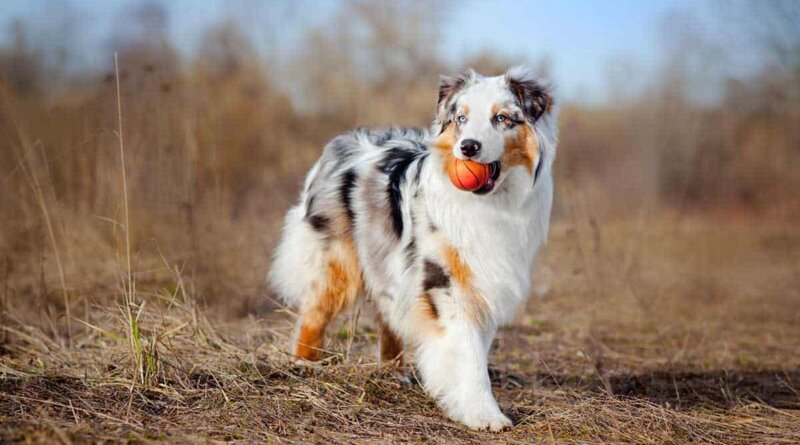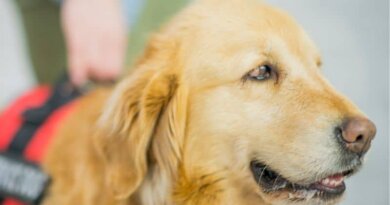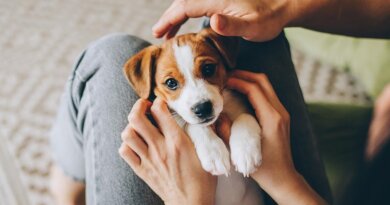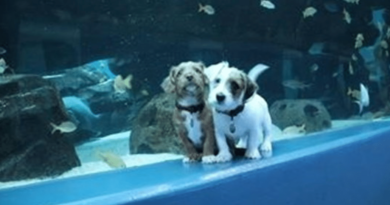The Miniature Australian Shepherd – Herding Dog For The Home
This post may contain affiliate links. We may earn money or products from the companies mentioned in this post.
Australian Shepherds are intelligent, lively, and friendly dogs, but can be considered a little large to be a household pet. Enter the Miniature Australian Shepherd, often just called the MAS, a small variety of this sporting dog that won’t exceed 18 inches tall.
While the MAS is a new breed, only recognized by the American Kennel Club in 2015, they are quickly becoming very popular as pets for energetic individuals looking for a companion to join them on all their adventures.
Be warned, while very rewarding dogs, they are not for the faint of heart. Caring for them is a big commitment.

Read on for our complete guide to this amazing dog and to decide whether they might be the right pup for you.
Essential Statistics
- Pure-bred
- 13-18 inches tall
- 20-40 pounds
- 12-13 year life expectancy
- Herding breed
- Intelligent
- Highly trainable
- High-shedding double coat
History Of The Breed
Australian Shepherds were developed in the United States in the 19th century from sheep herding dogs imported from Australia and New Zealand.
While they were initially bred specifically for herding in California, they quickly, these intelligent and friendly dogs quickly became popular companion dogs.
As it became increasingly popular to keep these pups at home, a desire for a smaller, more house-friendly version of the breed began to emerge.
The Miniature Australian Shepherd began to be developed in the 1960s by breeding small Australian Shepherds. The desired size was reached in the mid-1970s.
While the MAS is small, it can still be used for work and competition but is a bit happier in a family home.
These dogs have also become very popular as rodeo dogs thanks to their work ethic, herding skills, and smaller stature.
Miniature Australian Shepherds are sometimes also called Miniature American Shepherds since they were bred in the United States, but the official breed name is Australian because they descend from Australian herding dogs imported to America.
Appearance And Physical Characteristics
Australian Shepherds are medium-sized dogs measuring 18-23 inches tall and weighing up to 70 pounds.
The Miniature Australian Shepherd is quite a bit smaller, measuring between 13 and 18 inches tall with the females usually on the smaller side, and weighing between 20 and 40 pounds.
The MAS has a strong and athletic body that isn’t bulky, which gives them a look of speed and agility.
They have a clean-cut head and neck proportional to the body, with a topline level from the withers to the hip joint. They tend to have a natural bobtail, though it is often docked.
Their double coat is medium-to-long, can be straight or wavy, and often has moderate feathering, especially around the back of the legs. They will also tend to have a mane or frill around the neck.
The most popular colors are black, blue merle, red merle, and red (liver), but each dog looks very different thanks to marbling, flecking, and blotching of the coat.
Personality And Temperament
There is a joy and natural friendliness about the Miniature Australian Shepherd, which is part of the reason that they are so popular as pets. They bond with their family incredibly quickly and will become loyal and protective.
They can be wary of strangers, so they do need to be socialized from a young age, but these pups pay attention to detail and can learn the difference between “new” and “threat.”
These dogs are highly intelligent and can learn almost anything since they are eager to please and respond well to positive reinforcement training.
They actually need to learn; they have a strong work ethic and get fulfillment from having a task to do. If they aren’t challenged regularly they can easily become bored, and a bored Miniature Australian Shepherd tends to be a destructive dog.
While MAS dogs love their people, they are quite independent and can get along on their own for a few hours, as long as they have an outdoor space.
They need a backyard when trapped at home since they will get into trouble if left inside, but make sure your yard is securely closed as they are intelligent enough to escape.
These dogs are very energetic and need lots of exercise. There is nothing that they will love more than accompanying their people on hikes and other adventures.
They also enjoy rough and tumble play with kids. This can be great for older and more active kids but can be a bit much for smaller children. Another reason that the MAS is not a great match with small children is their strong herding instinct.
Small children often don’t know how to respond to this. They will also want to herd any other animals you have at home, even if they are bigger than them.
Their high prey drive is sometimes interpreted as aggression, but this is not the case. These dogs are never aggressive, and in fact, the American Kennel Club considers aggression a disqualifying characteristic.
Miniature Australian Shepherds are not very vocal dogs, and will only bark if it is part of their work, they are in distress, or they are alarmed by a threat. If your MAS starts barking, you should pay attention.
How To Care For A Miniature Australian Shepherd
First and foremost, Miniature Australian Shepherds need lots of exercise. As adult dogs, they should be getting about 90 minutes a day.
This should usually be an hour on the trail and then a separate half-hour play session. If they don’t get this exercise, they will become frustrated with pent-up energy and can become obnoxious and destructive.
Even so, it is important to remember not to over-exercise puppies even if they seem enthusiastic to be moving. Over-exercising is one of the chief causes of growth abnormalities in dogs.
As a rule, until they are fully grown dogs should have about five minutes of exercise per day for each month of their life, so a six-month-old pup needs about 30 minutes.
Read more about exercising puppies here.
While these dogs are full of energy, it is important to remember that they are small dogs so it is easy to overfeed them. Most MAS need 800-1200 calories per day.
You can read more about proper feeding, especially for puppies, here.
The MAS is independent enough that you can leave them alone for several hours while you are at work, but only if they have a secure outdoor space to use. If you leave them inside the home they will become frustrated and destructive.
Beware that these dogs are intelligent enough to escape if you leave any holes in your security.
Their work ethic means that they require the challenge of learning new things, so it is a good idea to take the time to teach your dog tricks. Use positive reinforcement training; these dogs need to trust their people one hundred percent.
If you punish them, they will quickly learn that you are probably not to be trusted. There really should be no need, though, as these dogs will master new skills and essential skills such as house training very quickly.
Miniature Australian Shepherds can be wary of strangers and have a tendency to herd. It is important to socialize them from a young age so that they learn not to jump at or herd people and pets, and to ensure that their protective instincts remain in check.
These dogs shed a lot, especially during the spring and fall shedding season. They should be brushed daily to manage their coat and remove debris that can easily get caught up in it.
Since they tend to be outdoor dogs, they also need to be bathed pretty regularly. Bathing on a weekly basis is probably sufficient, but this depends on their lifestyle.
Health Concerns
Miniature Australian Shepherds have a good lifespan of 13-15 years. While they are generally healthy dogs, they can be prone to certain health concerns as several chronic diseases and genetic traits exist in the gene pool.
Progressive retinal atrophy is a particular concern, as are hereditary cataracts, iris coloboma, and microphthalmia. These can all leave these dogs prone to developing issues with their vision in later life.
These dogs can develop hip and elbow dysplasia, which is a deformity of these joins developed while growing. This is best prevented by not over-exercising these dogs while they are puppies which can help prevent an imbalance in growth in different parts of the body.
They can also develop degenerative myelopathy, a disease affecting the spinal cord that can cause weakening and eventually paralysis in the hind limbs.
In addition, they may have the multi-drug resistance gene which alters the blood-brain barrier that can affect their response to drugs.
Exposure to certain drugs can result in serious neurological problems such as hypersalivation, ataxia, blindness, tremors, and respiratory distress.
Cost Of A Miniature Australian Shepherd
The relative newness of the Miniature Australian Shepherd means that there are a limited number of breeders, and therefore you can expect the puppies to be quite expensive.
It is not unusual to pay between $1,000 and $3,000 for a MAS puppy from a reputable breeder.
Should I Adopt A Miniature Australian Shepherd?
Having read our guide, are you still wondering whether the Miniature Australian Shepherd is the right dog for you? Ask yourself the following questions to make your final determination.
How Big Is My Home?
While the Miniature Australian Shepherd was bred to make versions of the popular herding dog more appropriate for the family home, these small dogs do need a bit of space.
They will struggle with apartment living and probably get destructive. They really need a home with a backyard so that they can keep themselves occupied when left alone.
How Much Time Do I Have To Spend With My Dog?
The MAS is not a dog that can almost never be left alone. They won’t develop depression or separation anxiety if they don’t have human companionship for a while.
These dogs do need lots of exercise and mental stimulation, so you need to ensure that you and your family have the time to give it to them.
This includes at least 90 minutes of exercise a day (split into two sessions), and regular training sessions plus daily grooming. You need to be able to make the time commitment to successfully raise a MAS.
Are You An Experienced Dog Owner?
Miniature Australian Shepherds are easy to train, so some people suggest they can be a good match for first-time owners; however, they are high maintenance in terms of the attention they need, and they also need an owner who can command their trust and attention.
These dogs can be a handful for anyone who isn’t confident in raising a canine.
Do I Have Asthma Or Allergies?
MAS dogs shed a lot. This can be a major problem for anyone with asthma or allergies, or anyone who likes to keep their home free from dog hair. While regular grooming can help keep things under control, dog hair is just a fact of life with a MAS.
Do I Have Small Pets Or Children?
These dogs have a strong herding instinct and will want to herd any pets or small children that you have at home.
While proper socialization can help control this, the instinct is very strong. If you have small children, you might want to consider waiting until they are old enough to understand what is happening.
FAQs
How big will a Miniature Australian Shepherd get?
MAS dogs can vary quite a bit in size, weighing between 20 and 40 pounds. They shouldn’t get any bigger than 18 inches tall, but they can also be as small as 13 inches. The females tend to be noticeably smaller than the males.
When do Miniature Australian Shepherds reach full size?
Typically a Miniature Australian Shepherd will reach their full height by the time they are 18 months old, but they can still be a bit lanky and disproportionate and will probably keep filling out until they are around 2.5 years.
At what age do Mini Australian Shepherds start going into heat?
Most female MAS dogs will experience their first heat somewhere between 12 and 18 months of age. Smaller dogs tend to go into heat sooner and can start from as young as six months.
Larger dogs tend to take a bit longer and can be as old as two years before their first heat.
When should I neuter my Australian Shepherd?
Unlike some other breeds, there does not seem to be a strong correlation between cancer and neutering in male MAS dogs; however, the risks are greater for females, and they should not be spayed until they are at least six months old.
Many vets suggest waiting even longer to prevent cancer-related issues.
Are Australian Shepherds easy to potty train?
Miniature Australian Shepherds are intelligent, both easy to train, and good at learning what is wanted from them instinctively.
This means that they can be house trained relatively easily. It also helps if they have regular access to outdoor spaces to burn off energy. They will quickly learn where it is appropriate to do their business and where it isn’t.
Do Australian Shepherds calm down after spaying?
While you might notice some behavioral differences in your MAS after spaying or neutering, these energetic dogs are likely to remain high-energy even after the procedure.
Don’t expect them to start to slow down until they start to enter their senior years.
How much does a Miniature Australian Shepherd puppy cost?
MAS dogs are very popular, and as a relatively new breed there are few reputable breeders out there.
This means that they can charge a premium for these desirable pups. Expect to pay between $1,000 and $3,000 for a puppy depending on supply and demand where you live.
The Verdict
If you are looking for a lively, loving, and intelligent dog that can join you on all your adventures, but can thrive in a family home rather than needing an entire farm, the Miniature Australian Shepherd is a great breed.
These intelligent dogs can learn anything and bond quickly with their family members. They aren’t aggressive, they aren’t barkers, and they will just love being part of your family.
Be aware, however, that they need lots of exercise, mental stimulation, and grooming. They also need a firm hand, so they aren’t a great match for anyone without the confidence or commitment to raise a high-energy dog.
If you make the commitment to raise a Miniature Australian Shepherd the right way, though, they will make the perfect partner in crime for an active couple or family.
Do you have experience raising a Miniature Australian Shepherd?
Share your experience with the community in the comments section below.
Save To Pinterest

Top Picks For Our Puppies
- BEST PUPPY TOY
We Like: Snuggle Puppy w/ Heart Beat & Heat Pack – Perfect for new puppies. We get all of our Service Dog pups a Snuggle Puppy. - BEST DOG CHEW
We Like: Best Bully Sticks – All of our puppies love to bite, nip, and chew. We love using Bully Sticks to help divert these unwanted behaviors. - BEST DOG TREATS
We Like: Wellness Soft Puppy Bites – One of our favorite treats for training our service dog puppies. - BEST FRESH DOG FOOD
We Like: The Farmer’s Dog – A couple months ago we started feeding Raven fresh dog food and she loves it! Get 50% off your first order of The Farmer’s Dog.
Check out more of our favorites on our New Puppy Checklist.




